Jewellery and the Hip-Hop culture
By Emilie Bérard and Marion Mouchard
Hip-hop is a cultural movement that emerged in New York in the early 1970s1 against a backdrop of impoverishment in the poorer neighbourhoods of Harlem, Queens, the Bronx and Brooklyn. It comprises four practices: graffiti, breakdancing, deejaying and rap. One of its characteristics is the desire to belong to a socio-economic group on the one hand, and to a clan, neighbourhood or community on the other.
Above all, it promotes ostentatious individualisation, especially through appearance.
For members of rap culture, clothing and jewellery are a means of expressing status and identity: “In the 1980s, the way you dressed said more about you than anything else. […] so it had to fit perfectly and it had to define you2”. The choice of colours, brands and even the way in which shoelaces are tied are all used to communicate the group’s social status and origin3.
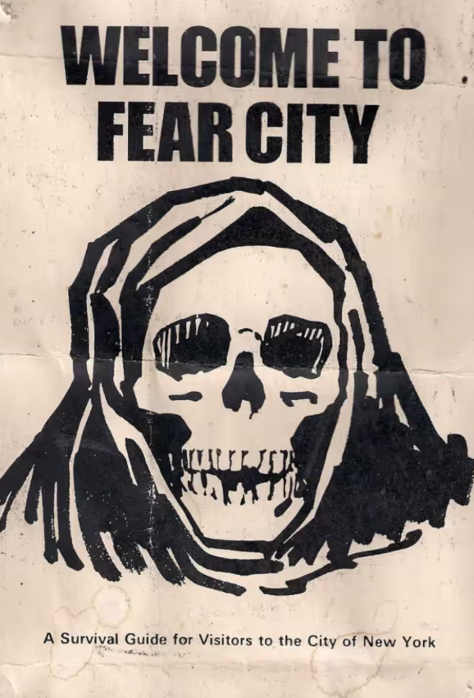
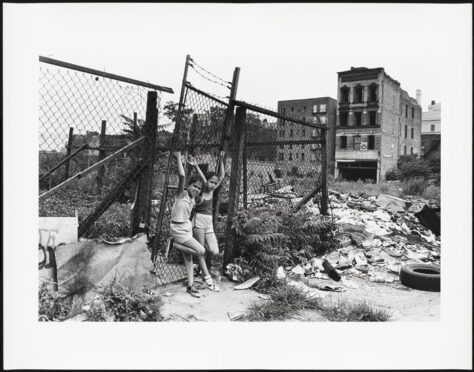
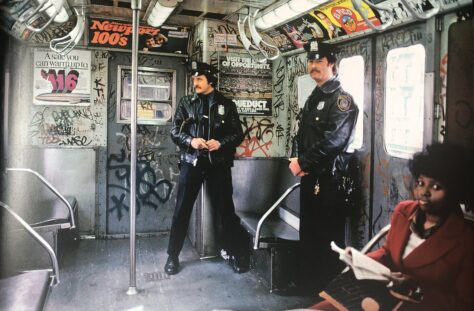
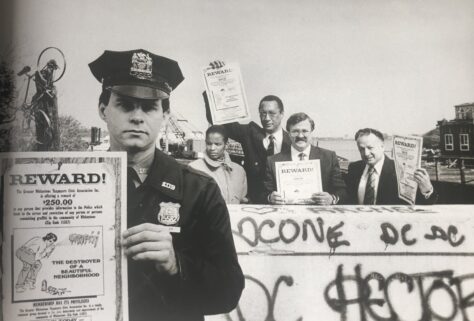


1 Elena Romero (dir.), Fresh Fly Fabulous. 50 years of Hip-Hop Style, New York, Rizzoli, 2023, p. 29.
2 « Around the way in the 80s, wardrobe said more about you than anything. […] it had to fit well, and it had to define you ». Ibid., p. 121.
3 Ibid., p. 115
A– Jewellery as a conspicuous sign of wealth
In rap culture, clothing and jewellery can be outward signs of success: the aim is to “dress like the person you want to be4”, and the ostentatious jewellery worn by rappers reflects their aspirations, whether financial or social. In the context of speculation and recession at the beginning of the decade, while traditional jewellers “(adapted) to the market by reducing the weight of their jewellery5” and a large part of New York’s population sold their jewellery to gold dealers on 47th Street6, members of hip-hop culture distinguished themselves with exuberantly proportioned gold jewellery worn in accumulation. Wealth is measured by the chains, grillz7 and gold watches bought on Canal Street in Chinatown. In 1985, Pebblee Poo in A Fly Guy assured the audience that his earrings were made of solid gold8.
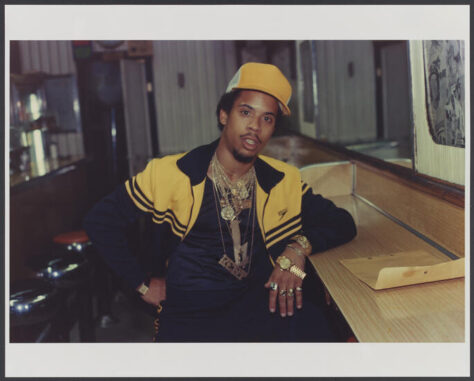
In addition to the materials, the iconography also reveals these ambitions, as do the graphic monetary symbols, especially the dollar. Similarly, branded clothing and jewellery are not just the preserve of yuppies, but also a marker of social success for members of hip-hop culture. Hip-hop culture plays a key role in accentuating this phenomenon. Through the practice of name dropping, rap lyrics reflect their authors’ obsession with brands: “Name dropping showed that you belonged to a different status than all the other people […] Fashion meant a lot. We had to dress up to be respected9”. Rap lyrics are indicators of what is fashionable. In “La Di Da Di”, the Get Fresh crew list the brands Gucci, Bally, Kangol and Ralph Lauren10. Gucci, Bally, Kangol and Ralph Lauren, along with Louis Vuitton, Versace, Armani and Tommy Hilfiger, are just some of the names of European and American luxury brands that are gradually being integrated and, above all, transformed by hip-hop style. There are also sportswear brands such as Adidas and Nike.
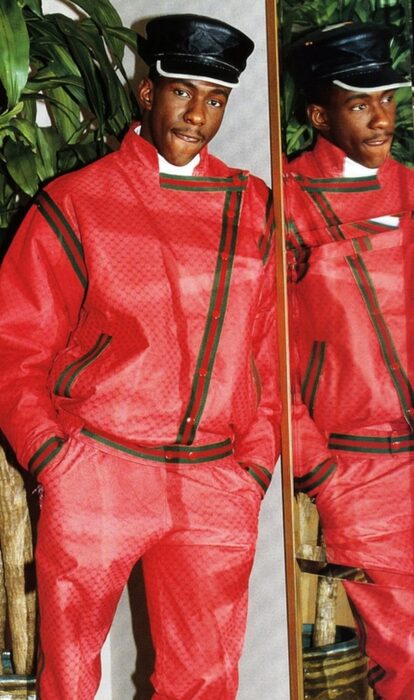
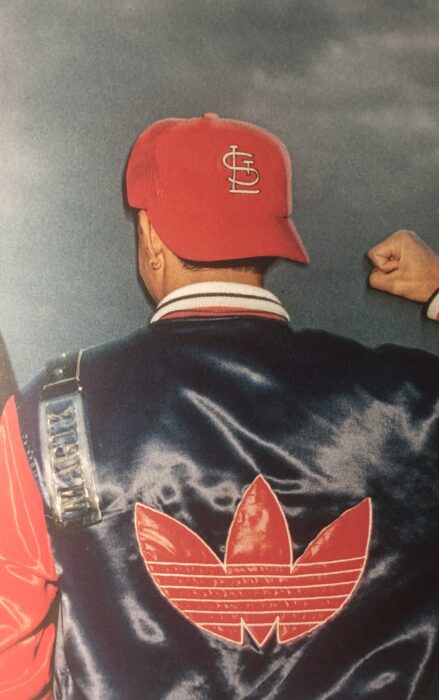
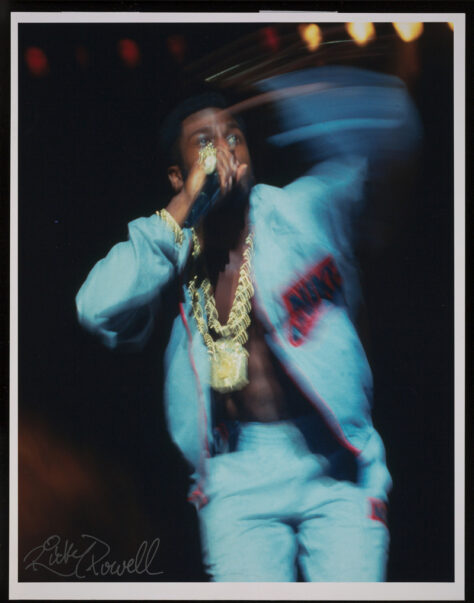
The work of Daniel Day, known as Dapper Dan, is one of the most famous examples.
He helped introduce luxury brands to hip-hop fashion – most notably Louis Vuitton, Gucci and Fendi. In his Harlem studio, which he opened in 1982, he uses logoed fabrics and leathers to create original designs11. Since then, his creations have been worn by the biggest rap stars such as Heavy D and Big Daddy Kane. Dapper Dan’s success is based on his understanding of clothing as a symbol that can change the way a social group views an individual. In Harlem at the time, the key to an appearance was what inspired admiration12.
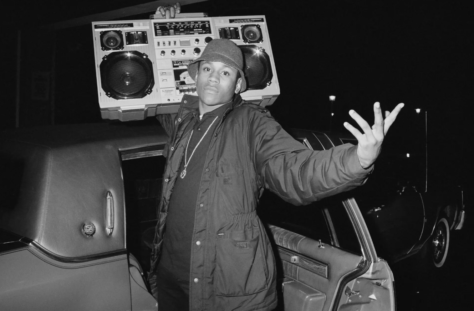
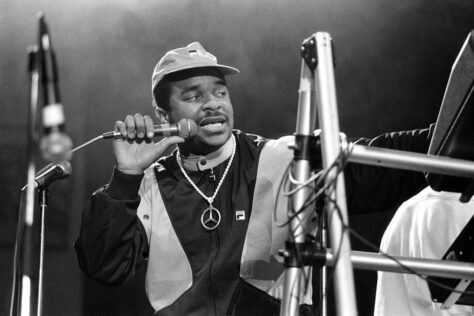

In jewellery, a recurring example is the pendant with the Mercedes-Benz car logo as its iconography. Numerous gold versions of various diameters are worn by rappers such as LL Cool J, Sir Mix-a-lot and Erick Sermon – leader of the group EPMD – to suggest their social success through the ownership of a luxury car.
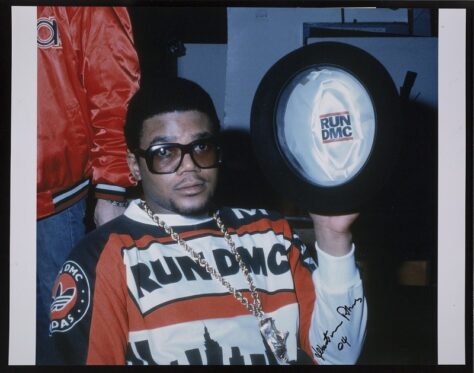
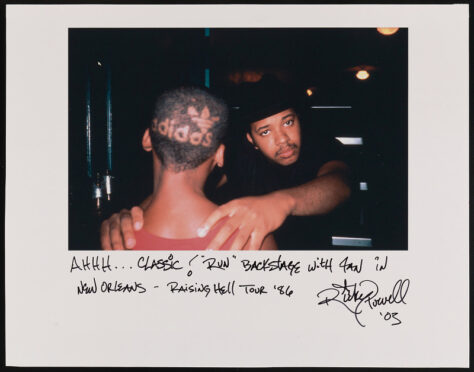
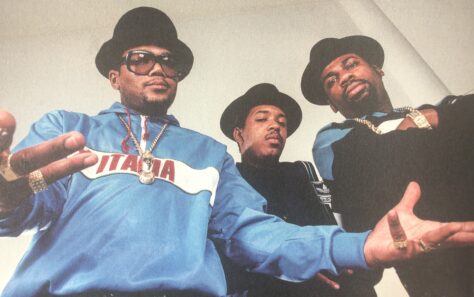
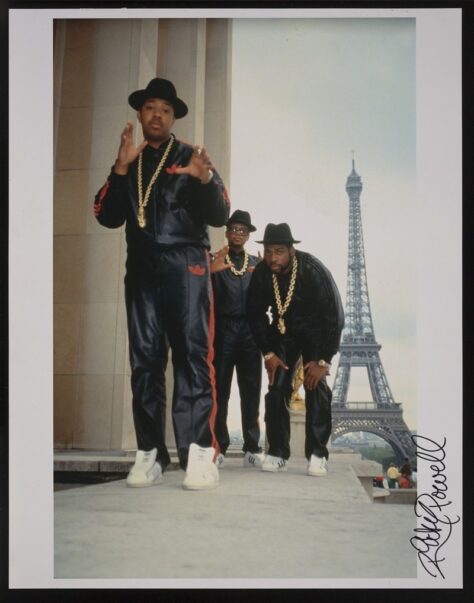
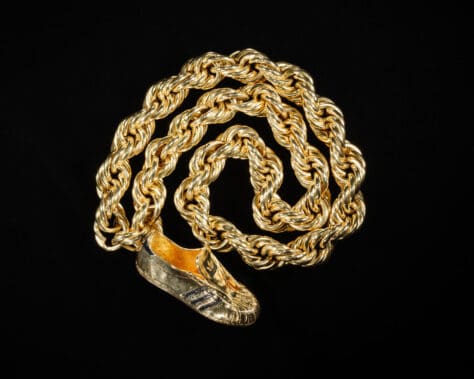
AIR JORDAN 1 COMMERCIAL: Banned! (1985) (youtube.com)
But the most eloquent example is undoubtedly the Adidas Superstar trainer pendant worn by the members of Run-DMC. In 1985, the rapper Dr Deas released a song called “Felon Sneakers”, a message aimed directly at sneaker wearers and denouncing the problems associated with them13. Run-DMC responded with an ode to the Superstar trainer: “My Adidas” was released in 1986 on the album Raising Hell. This was not the band’s first name drop. In 1984, in “Rock Box”, they mentioned jeans brands Calvin Klein and Lee14. The way they dressed created one of the most recognisable images of early hip-hop: often dressed in black, wearing Cazal glasses and, above all, laceless superstars with the tongue of the shoe facing outwards.
The track “My Adidas” was to make Run-DMC a success, leading to one of the first collaborations between a rap group and a brand. On 19 July 1986, they performed at Madison Square Garden and asked the forty thousand people in attendance to raise their Superstars in the air while they performed “My Adidas”15. This action and the spontaneous response it generated led Angelo Anastasio, the brand’s representative, to sign a partnership agreement with Run-DMC, negotiated by their manager Lyor Cohen.
The sportswear brands then redirected their advertising strategy, banking on the multiplier effect of the controversy and the new popular figures among young people. The 1984 agreement between Nike and Michael Jordan, number 23 of the Chicago Bulls, gave rise to one of the most famous advertising campaigns of the decade. One of the fruits of the partnership between Adidas and Run-DMC is a pendant offered by the brand to the group, bearing the image of the famous coach as worn by the three rappers. This piece of jewellery symbolises the partnership, which has become a benchmark in the sector, and testifies to the cultural power of hip-hop.
4 « Dress like the person you want to become ». Ibid., p. 33.
5 « Bijhorca », TF1, 12 septembre 1979, Paris, INA (cote : CAA7901677001).
6 « L’or, incidence sur la fabrication des bijoux », Soir 3, FR3, 16 janvier 1980, Paris, INA (cote : DVC8008015501).
7 Dental prostheses, often made of gold and sometimes set with diamonds.
8 E. Romero (dir.), Fresh Fly Fabulous. 50 years of Hip-Hop Style, op. cit., p. 171.
9 « Name droppin’ happened to show that you are on a different level than someone else… […] The fashion meant something. We had to adorn ourselves. We found respect. » Ibid., p. 97.
10 Ibid.
11 Ibid., p. 33.
12 Ibid., p. 79.
13 Ibid., p. 97.
14 Ibid., p. 99.
15 Ibid., p. 97.
B- Jewellery as an outward sign of group membership
For members of hip-hop culture, appearance is also a way of asserting their membership of a group on the fringes of the dominant culture, be it a gang, a neighbourhood or a community. Each group has a highly codified language of dress in which jewellery plays an important role. At the gang level, the colours of clothing and jewellery, the symbols that adorn them, and even the hand signs, all help to identify people in an underprivileged urban environment where the way you dress can lead to violence: “The trainers you wore could either get you mugged by thieves or make you look ridiculous, so you had to think very carefully about how you dressed16”.
By the 1970s, personalised jackets, painted in gang colours or emblazoned with gang logos, had been developed17. In the case of the rivalry between the Crips and the Bloods that accompanied the development of West Coast rap in the United States, blue was associated with the former and red with the latter. Similarly, each neighbourhood had its own dress code: in Brooklyn you wore Clarks Wallabee shoes, a Kangol cap and Cazal glasses, while in Harlem you wore tracksuits and the same brand of trainers18. The same neighbourhoods have their own speciality shops, including jewellery stores: Gold Teeth USA opened in Brooklyn in 1987 and A$ap Eva in Chinatown in 1988.
Hip-hop culture in particular, “born out of the segregation and oppression of communities of colour [African-American, Latino, Jewish, Chinese] in American urban centres19”, uses jewellery as a symbol of belonging to a community. In the case of African-American rappers, wearing jewellery is part of the political legacy of the civil rights and black power movements: “They were the post-civil rights generation who wanted equality and freedom. They wanted to have a voice, by any means necessary20”.
In 1989, the New York Times devoted an article to these trinkets, an affirmation of African identity: “It’s a throwback to the 1960s, to the era when civil rights and the Black Power movement inspired a generation of African-Americans […]. Once again, symbolic jewellery and clothing are worn by young African-Americans and become a statement of pride and identity21”. In the 1980s, the centre of African style and Black Power jewellery was in Harlem West22. To identify with this community meant wearing dashikis, kufis and slogan T-shirts23. In 1989, Queen Latifah and Monie Love appeared in the video for “Ladies First” wearing African turbans and Egyptian crowns24. In the same year, the Cross Colours brand was launched, promoting an African identity through fabrics and advertising campaigns25.
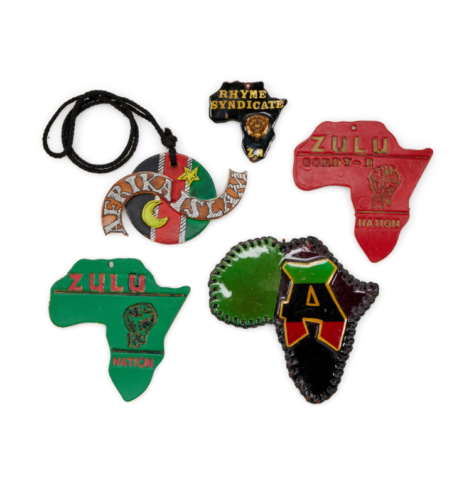
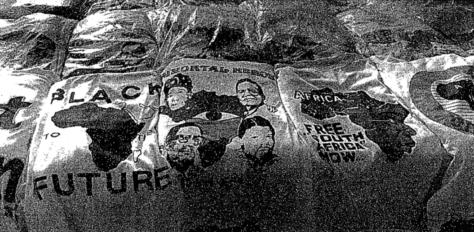
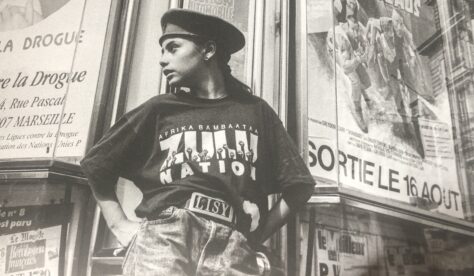
Pendants, one in the shape of an Ânkh cross, a second in the image of Elijah Muhammad, and a third with the inscription Zulu Nation, n.d., metal, leather, photograph, fabric, Washington, National Museum of African American History and Culture (object numbers: 2006.0067.11, 2006.0067.17, 2006.0067.12).
In the case of jewellery, the New York Times observed the wearing of “leather necklaces with red, black and green medallions, some forming the silhouette of the African continent, others with photographs of Malcolm X, Marcus Garvey and Haile Selassie26”. At the end of the 1980s, there was a relative “move away from gold” in rappers’ jewellery. The use of leather was sometimes preferred in order to be associated with iconographic references to Africa: “Rap pioneers such as Experience Unlimited, Heavy D and the Boys, Kool Mo Dee and Public Enemy – associated with the wearing of large gold jewellery – now wear African-inspired jewellery28”. A young man interviewed by New York magazine expressed his satisfaction at this reminder of the Afro-American political past, before adding: “At least it’s not these cheesy gold things anymore”.
Other pieces of jewellery, such as pendants in the shape of the Ankh cross, a bust of an Egyptian pharaoh or Queen Nefertiti, suggest a glorification of Africa’s ancient past. Following in the footsteps of Malcolm X, who wore a signet ring in the colours of the Nation of Islam, the rappers of the 1980s adorned themselves to assert their identity in a society that marginalised them.
Jewellery became a symbol of pride and self-assertion.
16 « The sneakers you wore on your feet could either get you robbed or get you roasted, so you had to dress defensively. » Ibid., p. 121.
17 Ibid., p. 50.
18 Sacha Jenkins, Fresh Dressed, 2015.
19 E. Romero (dir.), Fresh Fly Fabulous. 50 years of Hip-Hop Style, op. cit., p. 11.
20 « They were the post-civil rights generation who wanted equality and liberation. They wanted to have a voice by any means necessary. » Ibid., p. 65.
21 « They are throwbacks to the 1960’s, recalling the time when the civil rights and black power movements inspired a generation of young black men and women, when everything and anything black was beautiful. […] Once again, symbolic jewelry and clothing is being worn by young black Americans making statements of pride and identity. » Lena Williams, « In Leather Medallions and Hats, Symbol of Renewed Black Pride », The New York Times, 30 juillet 1989, p. 46.
22 E. Romero (dir.), Fresh Fly Fabulous. 50 years of Hip-Hop Style, op. cit., p. 65.
23 L. Williams, « In Leather Medallions and Hats, Symbol of Renewed Black Pride », op. cit.
24 E. Romero (dir.), Fresh Fly Fabulous. 50 years of Hip-Hop Style, op. cit., p. 33.
25 Ibid., p. 89.
26 « Leather necklaces with medallions of red, black and green, some shaped in the outline of Africa, others framing photographs of Malcom X, Marcus Garvey and Haile Selassie. » L. Williams, « In Leather Medallions and Hats, Symbol of Renewed Black Pride », op. cit.
27 « A Move Away From Gold ». Ibid.
28 « Rap grounds like Experience Unlimited, Heavy D and the Boys, Kool Mo Dee and Public Enemy – associated with the fad of large gold jewelry – now wear African-inspired jewelry. » Ibid.
C- Jewellery as a vehicle for individuality
Within hip-hop culture, the quest for social recognition also includes the individualisation of jewellery: “When luxury brands didn’t serve us anymore, we created our own luxury. The most satisfying reward was to be stopped on the street and asked: “Where did you get that?” and answering “What? You don’t know? I made it myself29”.
Hip-hop’s modes of expression impose the presence of its inventors in a socio-political context that marginalises them through systemic poverty, displacement and targeted austerity measures. More generally, customisation and re-mixing – that is, personalisation through the addition of a singular sign or the combination of elements from different or even opposing cultural sources – are at the heart of hip-hop culture, whether in the way people dress or in the adoption of nicknames. These phenomena can be seen as early as the 1970s in the clothes worn by B-boys and B-girls, who combined the style of urban gangs with sports shoes. Graffiti offered new images that quickly moved from walls and trains to album covers and clothing. Graffiti artists – such as Shirt King Phade – work on jackets and jeans to paint unique, personal logos.
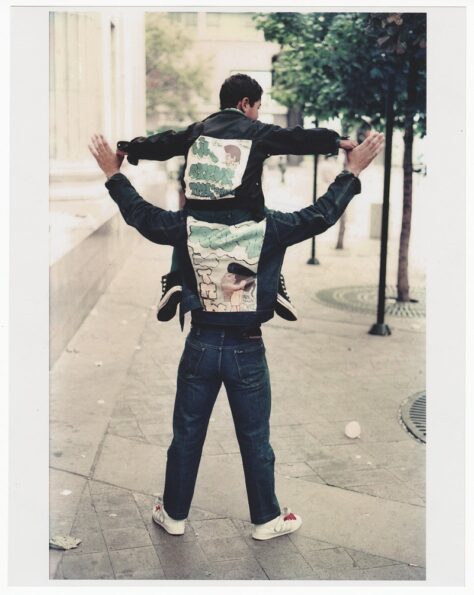
Similarly, Dapper Dan uses the logos of established European and American luxury brands but transposes them onto clothes with a loose fit derived from the urban culture of the time. In this way, Dan goes against the grain of the major labels: “I do not dictate fashion. I translate culture32”. He welcomes his customers – especially rappers, who were not welcome in the boutiques of Fifth Avenue at the time – and dresses them so that they become the best version of themselves through their clothes and their style33. By taking into account their music and personality, he created the image they wanted to project.
In short, “hip-hop’s translation of individuality was expressed through customisation. To have something that no one else has, […] to wear a unique piece of jewellery or a piece of jewellery with your name on it, is to show the world who you are34”. So the pioneers of hip-hop, who had no access to the big jewellery brands, had jewellery made that conveyed their individuality.
Namesplate jewellery is a prime example of this personalisation. They consist of a word, usually a name, inscribed in a metal plate with an openwork design and sometimes a stone. They come in a wide variety of styles: necklaces, earrings, rings, belt buckles and bracelets. There is also great freedom of choice in terms of size, typography, type of chain and ornamentation to frame the inscription, all of which can be used to create a unique piece of jewellery. In this way, nameplates were a way for early rappers to ostentatiously display their nickname, personality and individual identity.
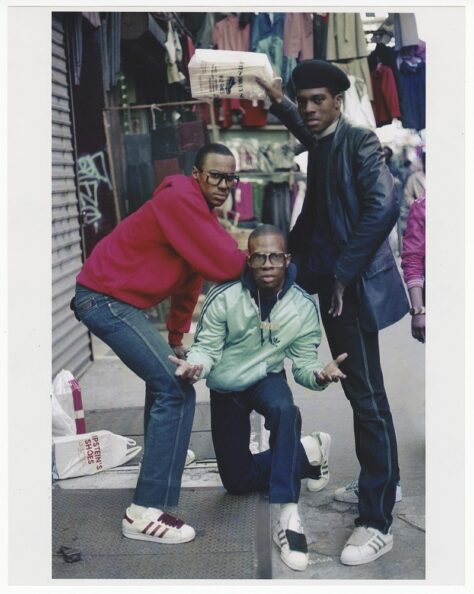


The rapper Kurtis Blow, for example, helped to shape the way rappers wore jewellery from the time of his first album: on the cover he is shown wearing an accumulation of necklaces and pendants, which at the time were of a reasonable size. On other occasions, he wears a pendant with his name on it: the letters “BLOW” are arranged vertically on a chain. The pendant thus became a distinctive piece of jewellery, imprinting the rapper’s style and image on the collective imagination.
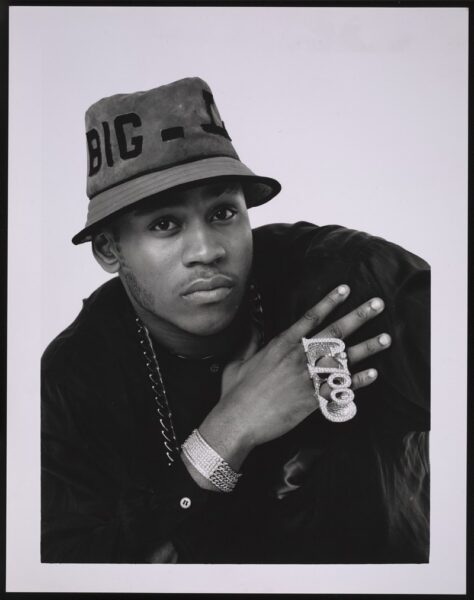
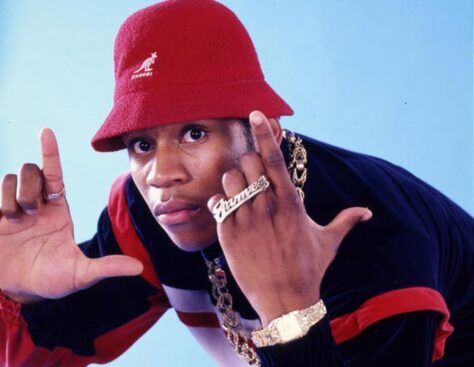
Rapper LL Cool J helped popularise the four-finger ring. He owned two rings – one with his birth name, James, with the last letter replaced by a “$”, and the second in yellow gold set with gemstones with his stage name.
In the 1990s, hip-hop culture began to gain legitimacy in the music and fashion industries. New School rappers such as Run-DMC helped to expand the influence of an alternative culture, hip-hop, on mainstream culture. The emergence of dedicated programming on free radio and television – including the important role of MTV, founded in 1981, in broadcasting video clips – helped to bring rap music and its style of dress to prime-time audiences.
The success of Dapper Dan, April Walker and Karl Kani also paved the way for the many hip-hop fashion labels that emerged in the second half of the 1980s, such as Cross Colours. Hip-hop fashion met with growing enthusiasm and saturated screens, as seen in video clips and television series such as The Fresh Prince of Bel-Air. At the same time, rappers set up their own independent labels. From then on, “artists promoting their own brand became the new norm for labels and their way of doing business. They demanded their own product placement and contracts began to reflect this35”. As rappers gained commercial and international recognition in the 1990s, it became easier for them to flaunt their success, which they could now easily afford or obtain through partnerships.
Hip-hop culture is becoming an industry in its own right, capable of working alongside haute couture and fine jewellery houses. A$AP Ferg’s collaboration with Tiffany in 2018 and Jay-Z and Beyoncé’s collaboration with Tiffany in 2021, confirm the changing way in which the luxury goods industry, and jewellery in particular, views hip-hop culture.
29 « When the luxury brands fall short and don’t serve us, we create our own luxury. The most satisfying payoff is when someone on the street asks that age-old question: “Where’d you get that from?”, my answer is always at the ready “What, you ain’t know!? I made it myself”. » Vikki Tobak (dir.), Ice Cold. A Hip-Hop Jewelry History, Cologne, Taschen, p. 9.
30 E. Romero (dir.), Fresh Fly Fabulous. 50 years of Hip-Hop Style, op. cit., p. 168.
31 Contraction de Breaking-Boys et Breaking-Girls, autrement dit des danseurs de breakdance.
32 « I do not dictate fashion. I translate culture. » E. Romero (dir.), Fresh Fly Fabulous. 50 years of Hip-Hop Style, op. cit., p. 79.
33 Ibid.
34 « Hip-Hop’s tradition of individuality was expressed through customization. To have something nobody else has, to make you piece a bit more unique, to wear an article of adornment made with a one-of-a-kind design, to rock jewelry displaying your name, is to show the world who you are. » V. Tobak (dir.), Ice Cold. A Hip-Hop Jewelry History, Cologne, Taschen, p. 19
35 « Artists endorsing their own brands became the new norm for record labels and how they did business. They demanded their own product placement, and contracts eventually started to reflect that. » Fresh Fly Fabulous. 50 years of Hip-Hop Style, op. cit., p. 122.
***
Émilie Bérard has a Master’s degree in History and Art History from the University of Grenoble-II and the University of Salamanca, and a diploma in Gemology from the Gemological Institute of America. For ten years she was Head of Heritage at the jeweller Mellerio International and has contributed to a number of publications, including the collective work Mellerio, le joaillier du Second Empire (2016).
She joined Van Cleef & Arpels in 2017 as Head of Archives and is currently Head of the Patrimony Collection.
Marion Mouchard holds a Master’s degree in Art History and Archaeology from the University of Paris IV-Sorbonne. She wrote two memoirs on the jeweller Pierre Sterlé (1905-1978) and the watch and jewellery designer and manufacturer Verger (1896-1945).
A doctoral candidate in art history at the Centre André-Chastel, she is working on a thesis on archaeological jewellery in the second half of the 20th century.
***
Learn more :
Ice Cold: An Exhibition of Hip-Hop Jewelry
American Museum of Natural History
Opening Thursday, May 9, 2024
Floor 1, Mignone Halls of Gems and Minerals, Meister Gallery
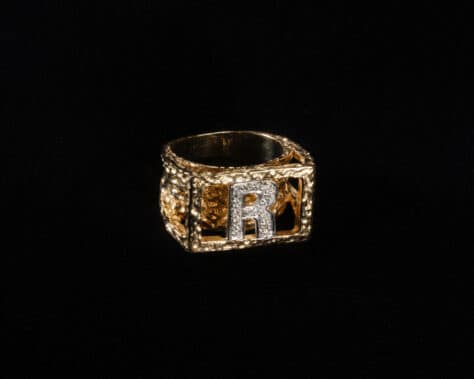
Roxanne Shanté, a member of the influential hip-hop collective Juice Crew as a teen in the 1980s, is the only female rapper to have been given a Juice Crew ring, which boasts a diamond-encrusted “R”.
Alvaro Keding/© AMNH
Ice Cold: An Exhibition of Hip-Hop Jewelry celebrates hip-hop’s cultural influence through stunning jewelry worn by some of its iconic stars. Building on New York City’s celebration of the 50th anniversary of hip-hop as a global phenomenon, Ice Cold will highlight the evolution of jewelry in hip-hop over the past five decades, starting with oversized gold chains embraced by rap’s pioneers in the 1980s and moving through the 1990s, when emcees turned business moguls sported record label pendants sparkling with diamonds and platinum.
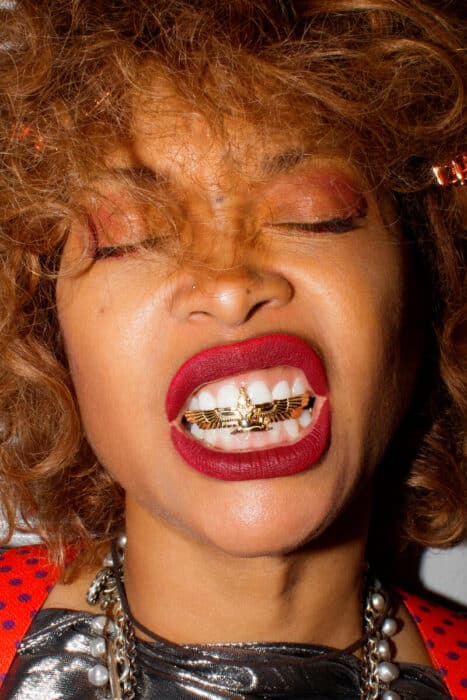
Front page image : This playful Lego pendant, designed for A$AP Rocky by Alex Moss X Pavē in 2022, is made of 14-karat gold with multicolored diamonds, sapphire, ruby, and enamel.
Please click on this link to subscribe to the Property of a Lady newsletter